It’s winter in Maryland. In fact, it’s so much winter I shoveled 10 inches of snow off my driveway this morning. Fortunately, I had company. It wasn’t the kind of company that picks up a shovel and helps out, but still, the American robins darting back and forth over my head were still welcome (if surprising and surprisingly quiet) snow day companions.
Become a Member
Make a lasting impact for nature when you join The Nature Conservancy
“You know,” I said to them as I leaned on my shovel to watch about 25 birds flock together in my neighbor’s oak. “I think y’all are a little early—aren’t you supposed to be the first harbingers of spring?”
We’re not even a month past the first day of winter in the northern hemisphere. Spring is definitely not here. So why are the robins? Shouldn’t they be sunning themselves in warmer climes?
The short answer: as long as there’s food, American robins—true to their name Turdus migratorius (“the wandering thrush”)—kind of spend their winters coming and going as they please.
Robin Migration (AKA Robin Wandering)
Robins do migrate—but they don’t necessarily follow a more or less straight line from north to south in the fall, then repeat the journey south to north in the spring. In the fall and winter, when the ground freezes, robins lose access to their meal of choice: worms, insects (adult and larval) and (occasionally) snails. That’s when they turn to their winter diet staple: mostly fruit, mostly berries.
The folks at Journey North, a project tracking robin movements run by the University of Wisconsin-Madison, put it this way, “Some robins retreat all the way to southern Texas and Florida (in fact, some of the largest winter flocks documented by the Christmas Bird Count gather in sunny St. Petersburg, Florida), but others winter as far north as they can find berries. So they have an enormous winter range. Robins do migrate, but it has more to do with food sources than with being faithful to the same places year over year.”
In that way American robins are somewhat akin to teenage boys—they tend to go where the best (or most abundant or most easily accessible) food is, stay until it’s depleted, and then move on.
So as long as there are enough berries and other fruits to sustain them, you may see robins off and on throughout the winter across much of North America.
Forget the birdseed though. Robins’ digestive systems, unlike sparrows or other so-called feeder birds, aren’t built for dealing with seed, and their beaks aren’t built for cracking things open. Robin beaks are built for snapping up worms, catching insects, and plucking berries and other fruits. In the winter, a flock of robins can strip a holly bush with impressive speed and efficiency, and very little—if any—violent robin-on-robin aggression.
Food is also one of the reasons that robins, notoriously territorial and aggressive in breeding season, tend to gather and travel in flocks in the fall and winter. Numbers are good for defense, and also for spotting food—if one robin happens on a holly tree full of bright, ripe berries, the whole flock can partake. And then move on.
The tendency of robins to flock in winter may also be one of the reasons people seem to notice them—birds in large numbers tend to stand out when they’re gathered in leafless trees. (That and the beautiful red breast that is sometimes the only splash of color in a winter landscape that looks practically lunar in relentless shades of February white and gray.)
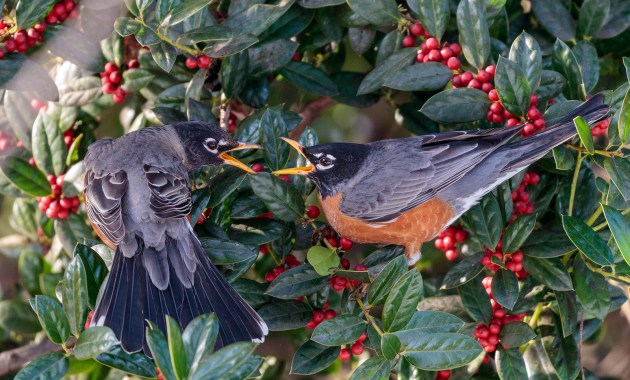
How do Robins Survive the Cold?
Robins are outfitted to survive huge temperature variances. In fact, hot weather seems to stress them more than cold.
If an American robin is healthy, has enough to eat, and is able to main its feathers, the temperature next to its body stays around 104 F—regardless of how cold it is in the world outside. It really is all about those feathers. (And the legs and feet.)
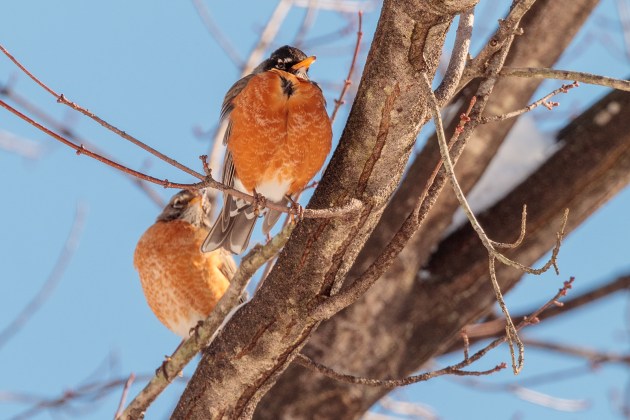
Robins, like most birds, have layers of feathers that perform different functions. When temperatures drop, robins puff the fine, downy feathers closest to their bodies to keep heat in, cold out. The outer feathers act like a kind of overcoat, shedding water and moisture and helping to regulate the bird’s temperature. (It’s an adaptation not limited to robins. Most birds with down feathers fluff them to regulate body heat).
The anatomy of a robin’s (and other bird species) also contributes to their cold adaptations. The bird experts over at the Cornell Lab explain it very well. The simplified version is that “most birds don’t succumb to frostbite because there is so little fluid in the cells of their feet, and their feet are mostly tendons and bones with little muscle or nerve tissue.”
So while blood does flow to their legs and feet, most birds (including robins) benefit from a very fast circulatory system and a “countercurrent heat exchange system.” Because bird legs are thin, the vessels that move blood from the heart to the feet and back again are very close together. That proximity means, per Cornell, “blood flowing back to the body is warmed by blood flowing to the feet. The newly cooled blood in the feet lowers heat loss from the feet, and the warmed blood flowing back into the body prevents the bird from becoming chilled.”
Robins: The Tell-Tale Birds of Spring
If robins are around in winter, why have they always been associated with the beginning of spring in the U.S.? Most likely it has to do with ground thaw, snow melt, and territorial behaviors like singing, worm hunting and nest building. But mostly, it’s the singing.
According to Journey North, which has a fantastic Q+A section I highly recommend for the robin-curious, “the robin’s song remains a reliable indicator that the first wave of spring migration has reached you. This song is one of the first signs that robins are switching from winter behavior to courtship and nesting behaviors associated with spring.”
Robins tend to move north as the ground thaws. The availability of high protein prey, especially worms that emerge with warmer, often wetter weather, is when a robin’s thoughts turn to procreation. And that’s the end of the cooperative fall and winter behaviors.
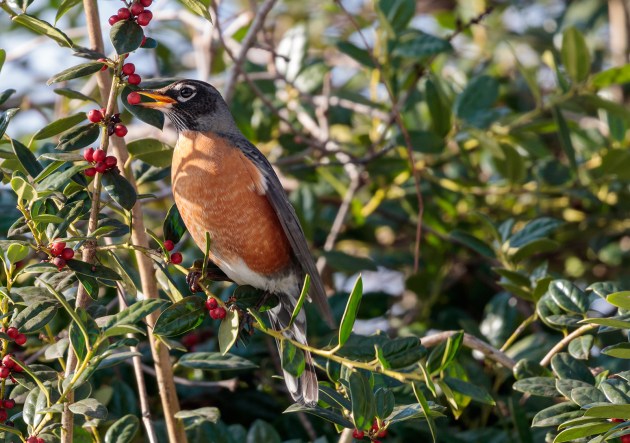
Which is one of the reasons many robins (primarily males) may stay through harsher winters instead of booking it to St. Petersburg: first access to the choicest nesting grounds. Breeding season is when robins also become more visible with mating displays, nest-building and a lot of time on the ground hunting for the tastiest worms. Until then, they’re all about the berries.
You Can Help Robins with Science from Your Own Backyard
Like many species, including other birds, scientists are starting to see some changes in robin behavior that is likely attributable to climate change. One study of American robins migrating to and from Canada’s boreal forest, showed that they’re beginning to journey south on average about 12 days earlier than in past years, or five days earlier per decade since 1994.
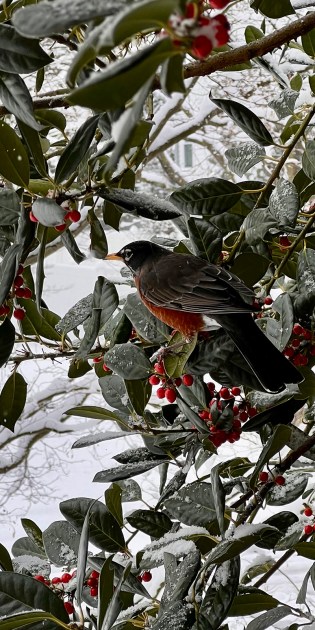
If you want to help scientists studying birds, there are several ways to contribute your observations (not just for robins, but for many of the species you can see outside your windows).
Journey North
You can submit your robin observations directly on the Journey North site (and check out their other migration-related citizen science projects). They also have 2025 maps tracking sightings so you can see where American robins (and other signs of spring) are being observed and follow along (and contribute to) the wanderings of Turdus migratorius.
Cornell Lab of Ornithology
The Cornell Lab has a number of different ways you can contribute to science for birds. Your sightings tracked on eBird (free) contribute to worldwide data for birding, science, and conservation. Want to know what birds are being seen in your neighborhood, eBird has a feature for that. If you’re new to birding, check out their genius birding ID app, Merlin.
You can also contribute to Project FeederWatch (requires subscription) by counting birds at your feeder from November through April. Your observations help scientists monitor changes in the abundance and distribution of birds, including the influence of changes in habitat, disease, and climate.
And mark your calendars for the 2025 Great Backyard Bird Count (February 14-17). Spend time in your favorite places watching birds—then report them to Cornell! It’s easy to participate, “in as little as 15 minutes notice the birds around you. Identify them, count them, and submit your counts to help scientists better understand and protect birds around the world. You can see the results from 2024 here.
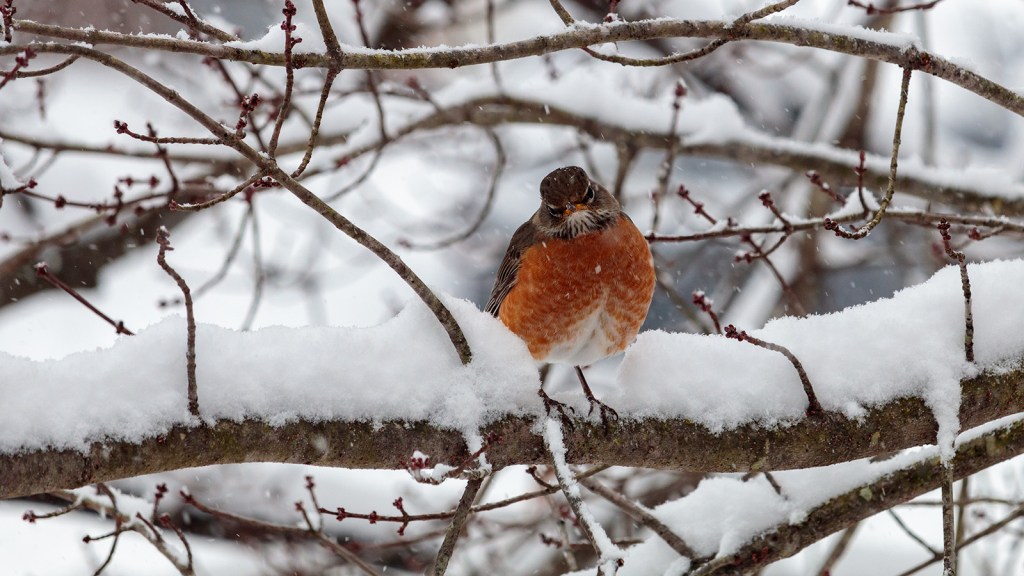



On Jan 18-19 about 40-60 Robins were all over a bush I have with berries. Never seen such movement or that many Robins. Fighting I guess. This happened the day Abilene, Texas began to get out of the snow and freezing temps.
Two weeks ago, prior to the freak series of storms that crippled the Dallas area, we saw a huge flock of robins outside our windows. Our yard is adjacent to a dog park which is rimmed with 6 ft tall holly bushes. These bushes had a bumper crop of bright red berries. This huge flock (70-100 birds) picked these holly bushes clean of berries and deposited their remains all over our tiled patio. We could almost see the robins growing bigger as they ate their way through the berries!
The following day after the berries were eaten, the storms started and we haven’t seen a robin since!
On one of the coldest day in the history of Texas, a huge flock of robins congregated on my neighbors holly tree ( where a mockingbird resides) and there was quite he ruckus! By the time I got out there, the robins were in my front yard maple tree! Big and fluffy with white bottoms that I’ve never noticed before. This was in North Richland Hills.
I live in Davison Mich 48423 and on February 13 2021 I saw a flock of robins. Most people didn’t believe they were robins
Feb 22, 2021 Dallas, TX – We saw hundreds of large bellied robins. I’ve never seen robins that big. They say things are bigger in Texas!!. We had snow and below freezing temps but they were flying all over the place enjoying their flight. It was amazing.
I had a flock of robins eating berries off my bush about 3 weeks ago, in northern Oklahoma. They ate all the berries and moved on.
I too had noticed flocks of Robins, before I had read your article. We just had the worst Winter Storm in Dallas in 100 years (-2 degrees) and I saw flocks of Robins everywhere. It was crazy. I loved your article. Thanks for the info! DCnTX
Just watched two Robins outside my window today in Michigan. The female waited in the tree while the male searched through leaves up against a brick wall. We warmed up some today so I believe this was their motivation to find some food.
B C Crawford
Our neighborhood has (well, had is more accurate) many hollies loaded with red berries, but February is the month when robins arrive in our zone (7) to eat them. It happened with our hollies in Lenoir, North Carolina and this year in Oxford, MS. I would say we saw thousands of robins descend last week and the week before. The swarms would settle in trees to take a break and then descend on the hollies. [Today’s date is February 22, 2021.] Now the hollies are ready to blossom again and produce more berries this year. Fortunately for me and the robins, hollies are my favorite native plant, and I have several hybrid varieties. Two holly hybrids that produce many berries are Nellie Stevens and her glossy sister Mary Nell. This year was the most prolific for holly berries and must have been for robins and a few other birds occasionally mixed in.
When the Artic fron reccently visited Texas with Frigid temps, large flocks arrived ahead of it. Most were all males as they had the red breasts
We had our first winter freeze storm in south Texas in more than 30 years last week. Even though there was snow on the ground I was surprised to see a flock of male robins in the yard. I had placed feed in the bird feeders but didn’t see any of them around the feeders. They were on the ground looking for insects & worms. As the snow disappeared they were in the muddy parts of the yard. I was excited because I had always understood that if you see robins, then spring is just around the corner.
San Antonio Texas — February 21 — after our Snow/Ice Storm, we noticed 4 or more Robins scratching in our back yard— First ones we have seen in years here in our yard?
My husband and I live in Lansing, Michigan. On Friday, Feb 19th we heard what sounded like hail on our skylights in our kitchen. We went to investigate and saw approximately 20 robins moving back and forth across our skylights. We have never seen a flock of robins and we were AMAZED!! We have always associated robins with spring and did not know they could survive so well in colder temps. It has been fun to learn more about our beautiful state bird. Winter can be a little long in Michigan so seeing them renewed our hope that spring is not that far away.
Robins spotted in Rockport, Texas (along Aransas Bay on South Texas coast) on February 3, 2021. I went to see if wildflowers were beginning to bloom in a cemetery that protects wildflowers which are spectacular in the spring, and they were coming up (a few Bluebonnets, Coreopsis and Louisiana Phlox already beginning to bloom), but it was REALLY exciting to see Robins feeding on the ground since none have been sighted in this area for many years. I posted a photo in Facebook’s Rockport-Fulton Living group, mentioned that it was quite a surprise, etc., and got many many comments from others indicating that Robins were all around this entire area, and all indicating that they hadn’t seen any for years as well. It seemed that all were delighted with this brief treat. Your article clearly explains what we considered a rather rare phenomenon. Thanks for sharing all the information. I may post a link to your report on R-F Living. … have to believe many would enjoy reading it.
I live in Mesquite, TX. Last week we had abnormally cold and snowy weather. The bad weather started on Sunday, Valentines Day. On Friday, 2/19, I noticed very unusual bird behavior out my front window in the trees. I couldn’t believe how many birds were out there. I watched for a while. They were constantly flitting around. There was so much energy. It almost looked choreographed. They were moving around mostly in groups. I kept watching. Suddenly I realized that they were almost all Robins. I couldn’t believe it. I’d never seen anything like this. I’d never seen this many Robins together, ever. It was amazing.